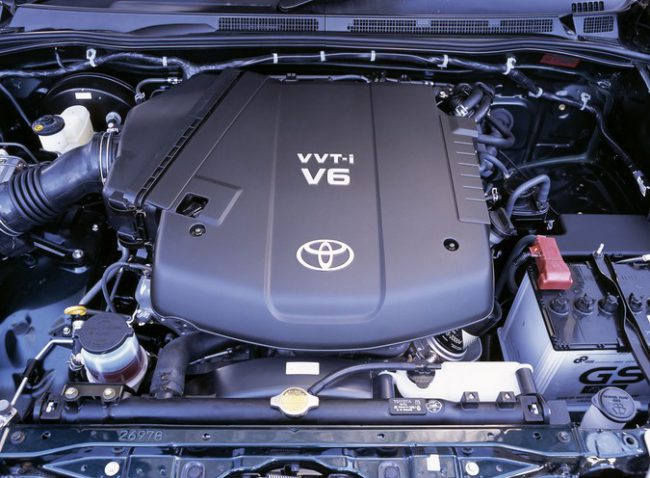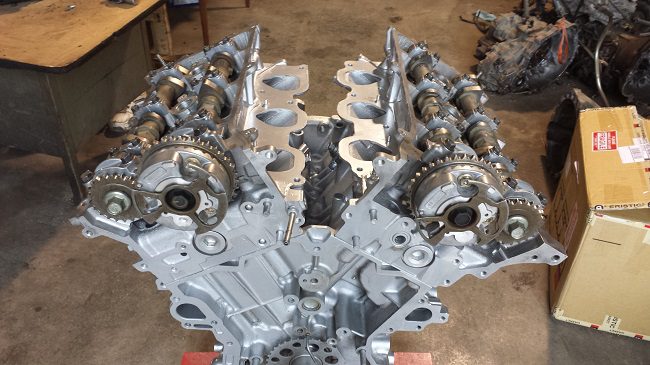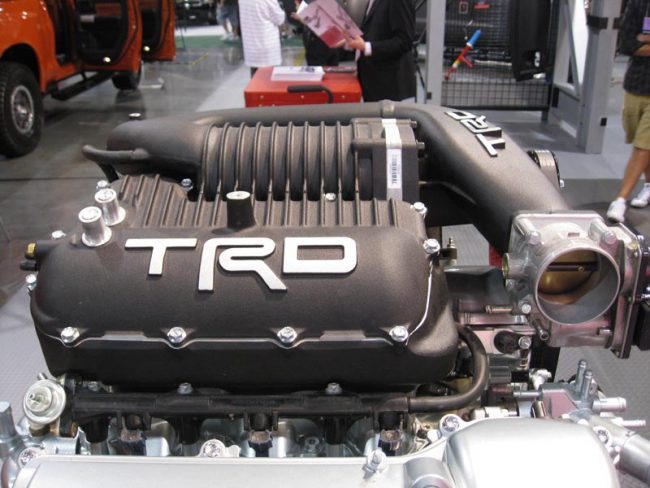
Toyota 1GR-FE engine
The Toyota 1GR-FE engine refers to Toyota's V6 gasoline engines. The first version of this engine was released in 2002 and gradually began to displace the aging 3,4-liter 5VZ-FE engines from the automotive market. The new 1GR compares favorably with its predecessors with a working volume of 4 liters. The engine came out not too revving, but enough torque. In addition to the 5VZ-FE, the 1GR-FE engine's mission was also to gradually replace the aging MZ, JZ and VZ series engines.

Blocks and block heads 1GR-FE are made of high quality aluminum alloy. The gas distribution mechanism of the engine has an improved DOHC configuration with four valves per cylinder. The engine's connecting rods are made from forged steel, while the one-piece camshafts and intake manifold are also cast from high quality aluminium. These engines are equipped with either multipoint fuel injection or direct injection type D-4 and D-4S.
1GR-FE can only be found on SUVs, which is obvious from its technical characteristics. The working volume of 1GR-FE is 4 liters (3956 cubic centimeters). Designed for longitudinal installation. The 1GR-FE cylinders actually form the square of the engine. The cylinder diameter is 94 mm, the piston stroke is 95 mm. The maximum engine power is achieved at 5200 rpm. Engine power at this number of revolutions is 236 horsepower. But, despite such serious power figures, the engine has an excellent moment, the peak of which is reached at 3700 rpm and is 377 Nm.

The 1GR-FE features a new squish combustion chamber and redesigned pistons. These improvements have significantly reduced the risk of detonation in the event of an adverse effect on the engine, as well as improved fuel efficiency. The new class of intake ports have a reduced area and thus prevent fuel condensation.
A special characteristic of the new engine, which will pleasantly surprise motorists, is the presence of cast-iron liners, pressed in using a new technology and having excellent adhesion to the aluminum block. Boring such thin sleeves, unfortunately, will not work. If the cylinder walls are damaged, then due to the occurrence of scoring and deep scratches, the entire cylinder block will have to be changed. In order to increase the rigidity of the block, a special cooling jacket was developed, which is designed to prevent overheating of the block and distribute the temperature evenly throughout the cylinder.
Below is a detailed table of car models on which the 1GR-FE engine was installed and is still being installed.
| Model name | The period in which the 1GR-FE engine was installed on this model (years) |
|---|---|
| Toyota 4Runner N210 | 2002-2009 |
| Toyota Hilux AN10 | 2004-2015 |
| Toyota Tundra XK30 | 2005-2006 |
| Toyota Fortuner AN50 | 2004-2015 |
| Toyota Land Cruiser Prado J120 | 2002-2009 |
| Toyota Land Cruiser J200 | 2007-2011 |
| Toyota 4Runner N280 | 2009–present |
| Toyota Hilux AN120 | 2015–present |
| Toyota Tundra XK50 | 2006–present |
| Toyota Fortuner AN160 | 2015–present |
| Toyota Land Cruiser Prado J150 | 2009–present |
| Toyota FJ Cruiser J15 | 2006 – 2017 |
In addition to Toyota cars, 1GR-FE has also been installed on Lexus GX 2012 J400 models since 150.

Below is a detailed list of technical specifications for the 1GR-FE engine.
- The engine is produced by concerns: Kamigo Plant, Shimoyama Plant, Tahara Plant, Toyota Motor Manufacturing Alabama.
- The official brand of the engine is Toyota 1GR.
- Years of production: from 2002 to the present day.
- The material from which the cylinder blocks are made: high-quality aluminum.
- Fuel supply system: injection nozzles.
- Engine type: V-shaped.
- Number of cylinders in the engine: 6.
- Number of valves per cylinder: 4.
- Stroke in millimeters: 95.
- Cylinder diameter in millimeters: 94.
- Compression ratio: 10; 10,4.
- Engine displacement in cubic centimeters: 3956.
- Engine power in horsepower per rpm: 236 at 5200, 239 at 5200, 270 at 5600, 285 at 5600.
- Torque in Nm per rpm: 361/4000, 377/3700, 377/4400, 387/4400.
- Fuel type: 95-octane gasoline.
- Environmental standard: Euro 5.
- Total engine weight: 166 kilograms.
- Fuel consumption in liters per 100 kilometers: 14,7 liters in the city, 11,8 liters on the highway, 13,8 liters in mixed conditions.
- Engine oil consumption in grams per 1000 kilometers: up to 1000 grams.
- Engine oil: 5W-30.
- How much oil is in the engine: 5,2.
- An oil change is carried out every 10000 (at least 5000) kilometers.
- Engine life in kilometers, identified as a result of a survey of car owners: 300+.
Disadvantages of the engine and its weaknesses
The first, pre-styled engines with a single VVTi do not have the widespread problem of oil leakage through the oil line at all. However, on car engines with fairly high mileage, in the event of overheating, a breakdown of the cylinder head gasket sometimes occurs. Therefore, it is necessary in this case to monitor the cooling system. On almost all 1GR-FEs, a characteristic “clatter” is heard during operation. Do not pay attention to it, as it is the result of the operation of the gasoline vapor ventilation system. Another sound, more like a chirping sound, occurs during the operation of the injector nozzles.
There are no hydraulic lifters on the 1GR-FE. Therefore, once every 100 thousand kilometers, it is necessary to carry out the procedure for adjusting valve clearances using shims. However, judging by surveys of car owners, few people are engaged in such adjustment. Unfortunately, most of us are accustomed to operating a car without any regular checks of its systems and assemblies for wear. Other disadvantages of the engine are listed below.
- As with most modern Toyota engines, there is noise in the head cover area when starting the engine, and various errors in the operation of the gas distribution mechanism are also possible. Manufacturers prescribe the difficulty of replacing timing elements, from sprockets to camshafts. Problems with sprockets worry car owners with this type of engine incomparably more often.
- Sometimes there is a problem with restarting the engine in low temperatures. In this case, replacing the mounting block will help.
- Fuel pump resistor problem.
- As mentioned above, sometimes there is noise or crackling at startup. This problem is caused by VVTi clutches and is considered a common feature of all engines in the GR family. In this case, replacing the clutch will help.
- Low engine speed at idle. Throttle valve cleaning will help solve this problem. This procedure is recommended to be carried out every 50 thousand kilometers.
- Once every 50-70 thousand kilometers, a pump can leak. In this case, it must be replaced.
Other disadvantages are indirect and not related to the reliability of 1GR-FE. Among them, there is the following drawback: as with most models with a transverse arrangement of the power unit, the resulting too high engine output turns into a decrease in the transmission resource. Sometimes it happens that with a transverse layout, access to the V-shaped engine is very difficult, for many operations it is necessary to disassemble the “inlet” of the engine compartment shield zone, and sometimes even hang the engine.
But such shortcomings are less common. If you correctly use the car without aggressive driving and driving on bad broken roads, then the engine will be healthier.
Tuning engine Toyota 1GR-FE
For engines of the GR series, a special tuning studio of the Toyota concern, called TRD (stands for Toyota Racing Development), produces a compressor kit based on the Eaton M90 supercharger with an intercooler, ECU and other units. To install this kit on a 1GR-FE engine, it is necessary to reduce the compression ratio by installing a thick cylinder head gasket or CP Pistons for 9.2 with Carrillo Rods, Walbro 255 pump, 440cc injectors, TRD intake, exhaust two 3-1 spiders. The result is about 300-320 hp. and excellent traction in all ranges. There are more powerful kits (350+ hp), but the TRD kit is the simplest and best for the engine in question and does not require much work.


The question of oil consumption at 1GR has long been of concern to Toyota Land Cruiser Prada drivers and is provided by the manufacturer up to 1 liter per 1000 km, but in reality such a high consumption has not yet been encountered. Therefore, when using 5w30 oil and replacing it at 7000 kilometers and topping up to the top mark on the dipstick in the amount of 400 grams, this will be the norm for this internal combustion engine. Manufacturers advise changing the oil every 5000 kilometers, but then the oil consumption will be almost clean. If the 1GR-FE is properly operated and serviced in a timely manner, then the engine life can reach 1000000 kilometers.

